Due to reader demand, we purchased a Dell PowerEdge R220 for review. The Dell PowerEdge R220 is the successor to the popular R210 and R210 II families which are solid low-end appliances. These are not the large virtualization servers but rather the servers meant for SMB racks, dedicated server hosting, and smaller bare metal application deployments. Dell produces scores of these servers so service, support and spares are generally easy to come by. In both of our colocation facilities, we have seen these Dell servers being run only a few racks down from the STH cabinets so they certainly seem popular. This review has not been Dell sanctioned, however we see the Dell PowerEdge R220 in many of the lower power density 120V racks and wanted to give one a try.
Test Configuration
We tried two test configurations with our Dell PowerEdge R220, a high-end spec and a lower-end spec. The difference being the lower end spec had 16GB of RAM and a lower speed/ thread count processor while the higher-end spec had the fastest Intel Xeon E3-1200 V3 series processor we could find.
- CPU: Intel Xeon E3-1220 v3 (low-end), Intel Xeon E3-1281 V3 (high-end)
- Memory: 16GB ECC DDR3 (4x4GB UDIMMs (low-end), 32GB ECC DDR3 4x8GB UDIMMs (high-end)
- Chassis/ motherboard: Dell PowerEdge R220
- Test Drives: 2x 4TB WD Red (low-end) 2x 400GB Intel DC S3700 (high-end)
The Intel Xeon E3-1281 we used has a retail price north of what many completely configured E3-1220 V3 systems will sell for. Still we wanted to test a popular low-end option with the highest speed E3 V3 chip we could. Frankly, both configurations worked well and there was adequate cooling.
Dell PowerEdge R220 Overview
Looking inside our Dell PowerEdge R220 we can see a relatively well laid out design. There are a total of four fans cooling which spreads enough airflow around the short depth chassis.
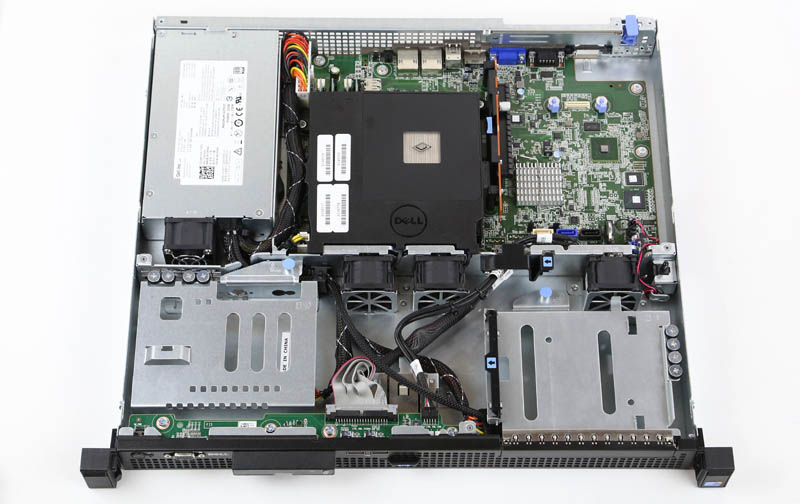
Underneath the CPU and memory shroud we can find the LGA1150 socket, passive heatsink and four RAM slots that accept up to 32GB. The dual chassis fans provide redundancy in the event of a failure so that air will still move through the shroud.

Next the CPU and memory is an internal USB type-A header. In the example below we used a SanDisk CZ43 as an ESXi boot drive. Certainly a nice touch for embedded OSes.

There is a single PCIe expansion slot in the chassis and plenty of room for most add-in networking or storage cards. We fit NVMe drives as well as network cards like Mallanox dual port FDR Infiniband cards in the riser.
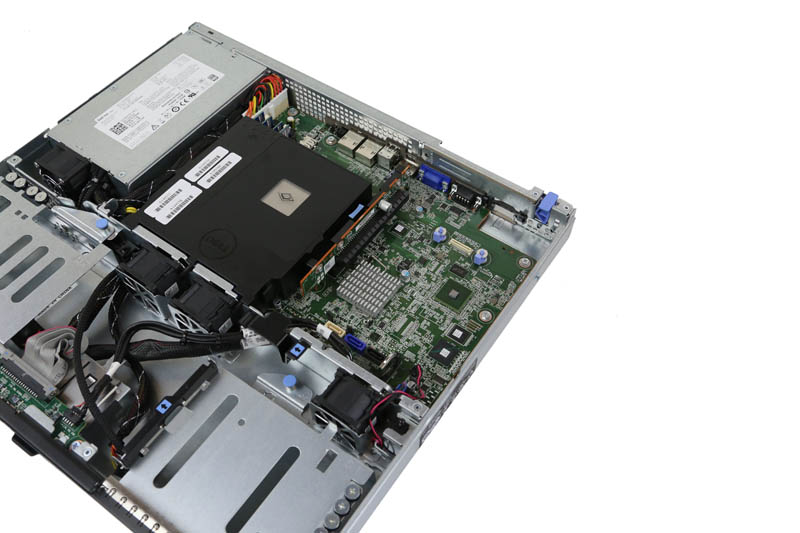
The rear of the Dell PowerEdge R220 had a number of ports on the back. There were legacy VGA and serial ports. Two USB 3.0 ports provided more modern connectivity. The R220 also had front I/O for VGA and USB to aid in the use of KVM carts in the datacenter. One can see two Broadcom based gigabit Ethernet ports. One unusual feature was the eSATA port which can be used for external expansion for those that shun the use of NAS storage. Finally the 80 Plus Silver power supply had a nice feature on the rear I/O panel: a cable management clip. That black clip on the right side of the image helps keep the cabling more organized which is important in the datacenter.
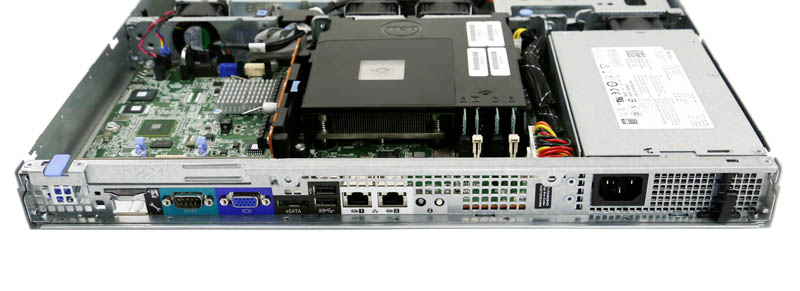
The chassis was designed to be largely tool-less. For example, the hard drive carriers released by pulling up on the blue pin and sliding the carrier out. While not hot swap, this was an easy-to-use design. The hard drive screws had rubber grommets and the screws attach to the hard drive tray to ensure they are there when a hard drive is added. One can also see nice touches like the latching cable guide (in black with the arrow below) to make cable management easier.
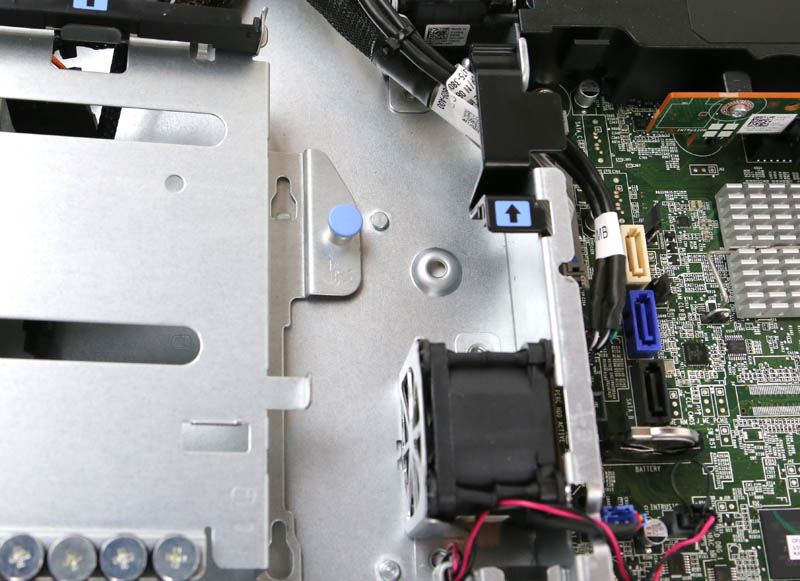
Racking the Dell PowerEdge R220 was simple and fast. Dell’s EasyRail kit allowed us to go from box to mounted server in under 5 minutes. That is excellent and we wish all vendors had similar easy mounting kits for their short-depth servers.
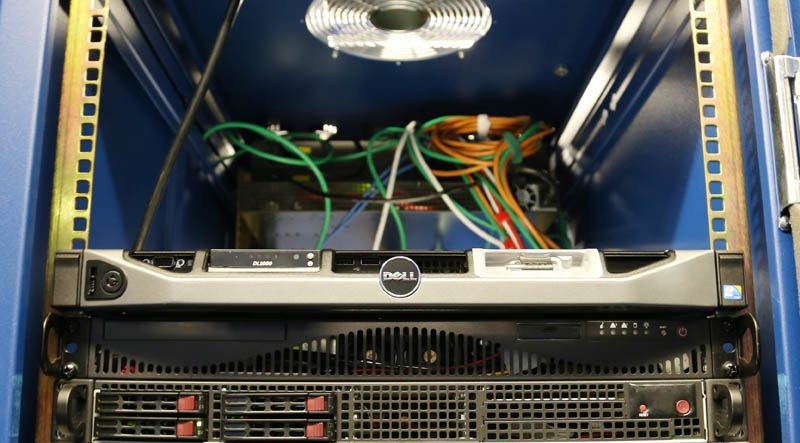
In terms of performance one can see an example of our Linux-Bench results here. Overall, the server was fairly easy to work with.
When things go poorly: The Latch
We decided at the last minute to make a configuration change in the server’s SSDs. As a result, we pulled the Dell PowerEdge R220 out of the rack and brought it to the workbench provided by the datacenter. Although the R220 had been an absolutely easy system to work with up to this point, something was wrong. The top latch decided it did not want to come un-hooked.
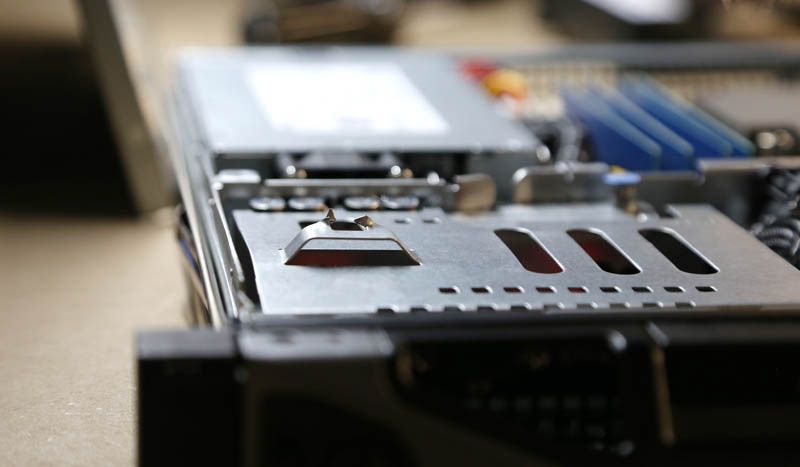
After about 15 minutes of going from gentle persuasion to a more forceful tone, the problem’s magnitude expanded. We had 5 minutes to pack up and head to our next meeting.

It appears as thought the top cover’s latch got hooked on the connection point and was unable to release. We tried applying weight to the chassis on different angles to get this mechanism to unhook but it did not work. The first dozen times we opened the R220 during testing this was not an issue so it may have been a fluke.
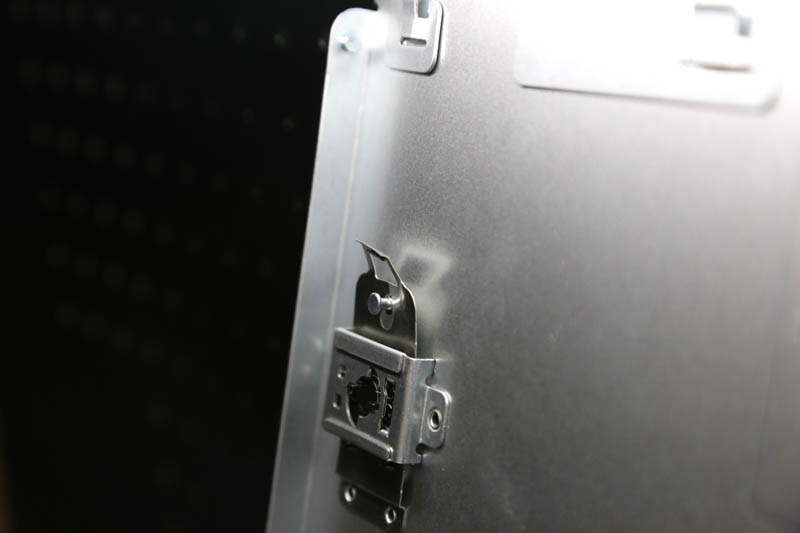
The metal was malleable enough that we could replace the cover without the latch engaging. The rear screws keep the chassis in place. We ended up making the meeting and the server has been up for 58 days straight since this.
Performance
We have covered the Intel Xeon E3-1200 V3 series extensively at STH. We are sharing some of our Linux-Bench runs with the Dell PowerEdge R220 and the Intel Xeon E3-1281 V3 processor.
7-zip Performance
7-zip is a widely used compression/ decompression program that works cross platform. We started using the program during our early days with Windows testing. It is now part of Linux-Bench.

Compression is a major function of storage servers, mail servers, web servers and just about any other application that makes up the modern network. As we can see, the Xeon E3-1281 V3 in our Dell PowerEdge R220 performed very well outpacing older 6 core/ 12 thread models and saw compression speeds rivaling older systems with twice as many cores.
OpenSSL Performance
OpenSSL is widely used to secure communications between servers. This is an important protocol in many server stacks. We first look at our sign tests:
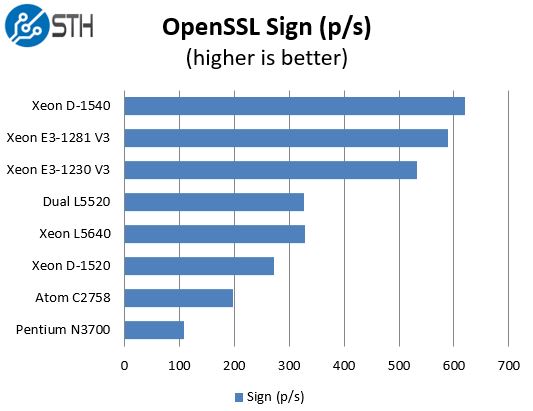
With OpenSSL being widely adopted, we can see the R220’s E3-1281 V3 performed better than the newer, lower power, Broadwell-DE based Xeon D-1520 system. The E3-1281 V3’s clock speed advantage was able to overcome the per-clock performance improvements of two Intel core generations.
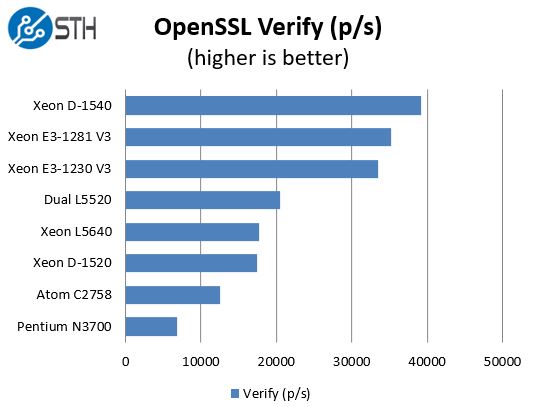
Again, we see OpenSSL performance of the E3-1281 near even the 8 core/ 16 thread Xeon D-1540 processor.
UnixBench Dhrystone 2 and Whetstone Benchmarks
Of course, these chips are not meant for heavy compute but we pick out the UnixBench 5.1.3 Dhrystone 2 and Whetstone results to show some of the raw performance they are capable of. UnixBench is widely used so it is a good comparison point.
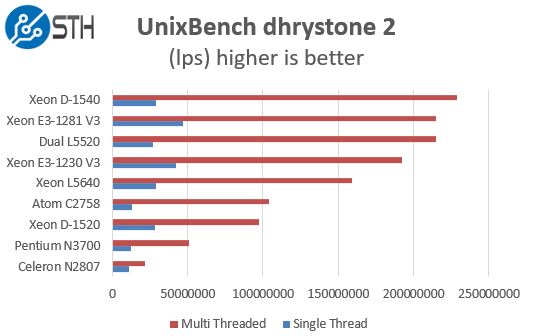
As we can see, the high clock speeds of the Intel Xeon E3-1281 V3 in our R220 show stand-out single threaded performance even in our first classic UnixBench test.
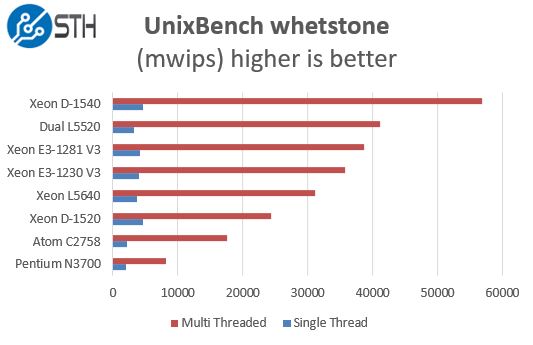
The pattern holds on the floating point side where se see strong single thread and multi-threaded performance from the quad core E3 V3 part due to its clock speed.
Remote Management
The Dell PowerEdge R220 has the capability for remote management. Dell, like HP and Lenovo, has a light version of iDRAC (Express) that allows basic functionality similar to other IPMI implementations.
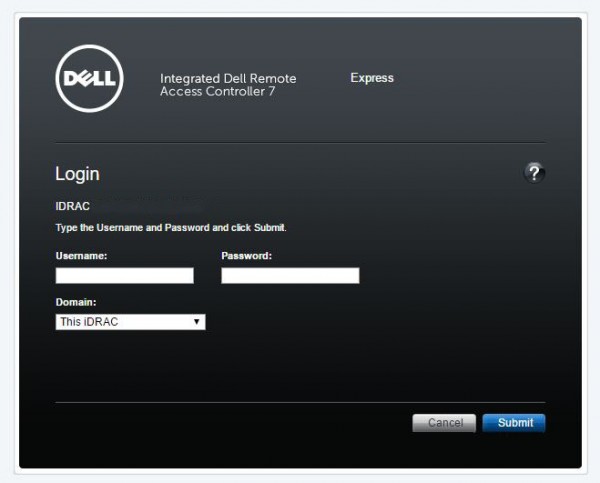
When one adds the appropriate iDRAC module, the management interface includes features such as KVM over IP to aid in setting BIOS and OS setup / troubleshooting tasks. We are not going in-depth with iDRAC 7 here as we did not have the expanded functionality. Our advice, as always, is to have an iKVM solution. Dell’s solution is particularly powerful because it is integrated into Dell’s OpenManage platform. OpenManage allows an administrator to administer one or many servers, storage, and networking devices all from a single interface. We will do a more in-depth piece of Dell’s iDRAC solutions as we get a newer platform. iDRAC has significantly more functionality than we have in our Dell PowerEdge C6100/ C6220 servers which have more industry standard IPMI/ iKVM functionality (as they were meant for larger scale cloud deployments.)
Power Consumption
If you spend time planning datacenter deployments, power consumption is always a primary concern. We used our Extech TrueRMS Power Analyzer 380803 to take measurements at different points of the board’s use. This will be one of our last power consumption figures on 120V power as we are transitioning to 208V power in our new datacenter lab soon.
- BMC only power off – 5.1w
- Ubuntu 14.04 LTS installation screen – 35.1w
- UnixBench 5.1.3 single thread max – 83.2w
- Multi-threaded max observed – 118.9w
The importance of these figures cannot be underestimated. The Dell PowerEdge R220 is very popular for the single server colocation/ dedicated web hosting market, which often uses 1A @ 120V as their maximum power density in racks. For example, in our low power 120V Fremont colocation facility where this machine will be based, the eight racks immediately to the right of ours are filled with these Dell PowerEdge R220’s to render flash for mobile browsers. Being able to create highly performant systems that fit under these common datacenter thresholds is an amazing feat and makes deployment planning very easy.
Conclusion
Overall we saw some solid performance from the Dell PowerEdge R220. The chassis was extremely serviceable and easy to install new cables, new drives, processors, memory, and add-in cards. The only hiccup is that it seems as though we had a defective latch on our test unit. The one area that we would have liked to see improved was the iDRAC module onboard. Dell makes one buy the iDRAC 7 module as an add-on feature. Pricing is such that you can buy competitor’s motherboards with embedded iKVM and dedicated OOB management NICs for less than the price of an iDRAC 7 module. We did have access to web based management with the Dell PowerEdge R220 that allowed us to remotely power cycle the unit. That is important for applications that require fencing and remote power cycling (e.g. Ubuntu MAAS). Still, in 2014/ 2015 this should be a standard feature. Racking the unit was very simple and other than the latch issue, the server was a pleasure to work with.





I didn’t understand in your conclusion if we can get Ubuntu MAAS to work with or without the iDRAC 7 module ?
For us SMB types looking at purchasing this unit, a sentence or two about SOUND LEVEL of the fans would have been nice; we do not have a dedicated server room.
Hi Dan,
A bit hard to do since it is in a data center. Generally I would strongly recommend a tower server if you do not have at least a dedicated server room.
Regards,
Patrick